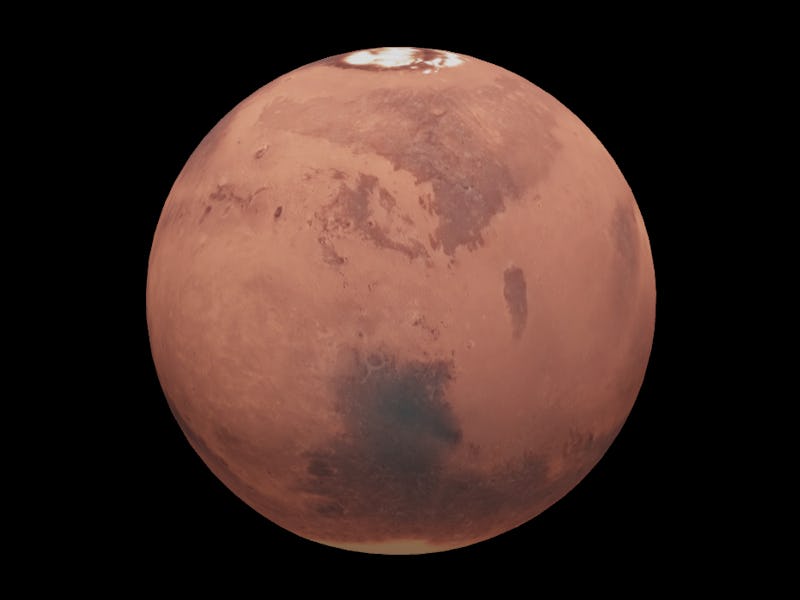The discovery of microbial life on Earth offers a new hope for life on Mars
“I am now almost over-expecting that I can find life on Mars.”

When we think of what life might look like on other planets, we might picture the Hollywood-induced image of green, slender aliens, or the more scientific approach -- tiny forms of bacterial life hidden beneath a planet’s surface.
But a recent discovery of a microbial form of life here on Earth gives scientists hope of finding life on Mars, and narrows down what they should be looking for in the ongoing search for life outside of our planet.
The discovery is detailed in a study, published this month in the journal Communications Biology, which follows a 10-year quest to find life hidden in the cracks of volcanic rock beneath the seafloor, and how that discovery can lead to the discovery of life in Martian samples collected from the Red Planet.
A colony of tiny microbial life was found wedged in tunnels on these volcanic rock samples.
The team of researchers found a community of bacteria on ancient volcanic rock, which they believe hold similar qualities to rocks on Mars. As a result, their discovery has initiated a collaboration with NASA to design a plan to find life on Martian rocks.
Microbial colony — The team of researchers behind the new study have been probing at these volcanic rocks for 10 years.
The rock samples were collected during the Integrated Ocean Drilling Program in 2010, which carried a group of researchers onboard a ship that traveled across the Pacific Ocean. The researchers drilled 125 meters below the seafloor, extracting rock samples that were between 13.5 million to 104 million years old.
Yohey Suzuki, associate professor at the University of Tokyo and lead author of the new study, had been trying to take a crack at the samples since, quite literally.
“I was making loud noises with my hammer and chisel, breaking open rocks while everyone else was working quietly with their mud," Suzuki said in a statement.
Suzuki and his team were attempting to find bacteria in the rocks by chipping away their outer layer, and grinding the center of the rocks into a powder. However, the team’s initial method was not successful.
Over the years, Suzuki developed a new method by coating the rocks in a special epoxy to support their natural shape, and then slicing off thin layers. He then washed the super thin layers with dye that stains DNA, and placed the samples under a microscope.
A thin slice of the volcanic rock, where microbial life was discovered.
And then bacteria appeared under the microscope in a colorful, glowing display of life hidden in the cracks of these volcanic rock samples. The bacteria was in the form of glowing green spheres, packed into orange tunnels, which are clay mineral deposits, and surrounded by black rock.
Microbial life appeared as glowing green streams under the microscope.
"I thought it was a dream, seeing such rich microbial life in rocks," Suzuki said. "Honestly, it was a very unexpected discovery. I was very lucky, because I almost gave up."
So, how did life get there in the first place?
It seems like an unlikely place to find any form of life, but the study suggests that the bacteria were attracted to mineral-filled cracks in the rocks which they use for nutrients to build their tiny colony.
Volcanoes erupting underwater produce lava at a scorching temperature of approximately 1,200 degrees Celsius. The lava eventually cools, and then cracks to become rocks. These cracks, which are around 1 millimeter wide, fill up with clay minerals over millions of years.
Bacteria are attracted to this clay, the same kind used to make pots, and therefore settle in those cracks to multiply.
"These cracks are a very friendly place for life,” Suzuki said. “Clay minerals are like a magic material on Earth; if you can find clay minerals, you can almost always find microbes living in them."
The new study estimates that the cracks are home to a community of bacteria as dense as that of the human gut, forming about 10 billion bacterial cells per cubic centimeter. Meanwhile, bacteria forming in mud sediments on the seafloor are around 100 cells per cubic centimeter.
In mud sediments, seawater dilutes the nutrients that the bacterial live off of, which is why the concentration of bacteria found on the volcanic rocks is eight times as much as those found in mud sediments.
Now, back to Mars — By now, you might be wondering what a tiny colony of microbes found beneath the seafloor of the Pacific Ocean has to do with a planet 135.81 million miles away.
NASA rovers are roaming the Red Planet, collecting samples for a future return to Earth.
The researchers behind the new study believe that the cracks filled with clay minerals found in deep ocean rocks are likely similar to the minerals that may be in rocks on the surface of Mars. This hypothesis is based on the idea that the deep ocean and the Red Planet share the same conditions of low temperature, moderate salinity, iron-rich environment, and basalt rock.
"I am now almost over-expecting that I can find life on Mars,” Suzuki said. "This discovery of life where no one expected it in solid rock below the seafloor may be changing the game for the search for life in space."
Suzuki’s team will begin a collaboration with NASA to put together a plan of examining the rock samples brought back from Mars by the space agency’s rovers.
NASA is launching the recently named Perseverance rover to the Red Planet this summer. The car-sized robot will spend at least one Martian year on the planet, the equivalent of 687 days on Earth, collecting samples of rocks and soil and setting them aside for a future mission to return them back to Earth.